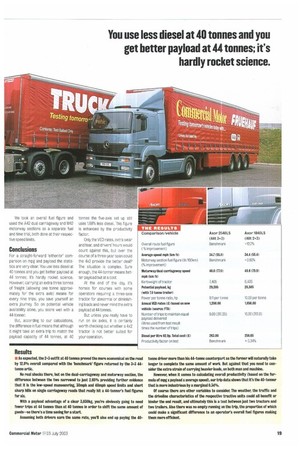Results
Page 19

If you've noticed an error in this article please click here to report it so we can fix it.
As expected, the 2+3 outfit at 40 tonnes proved the more economical on the road by 12.5% overall compared with the benchmark' figure returned by the 3+3 44tonne artic.
No real shocks there, but on the dual-carriageway and motorway section, the difference between the two narrowed to just 2.65% providing further evidence that it is the low-speed manoeuvring, 30mph and 40mph speed limits and short sharp hills on single carriageway roads that really hit a 44-tonner's fuel figures for six.
With a payload advantage of a clear 3,03ekg, you're obviously going to need fewer trips at 44 tonnes than at 40 tonnes in order to shift the same amount of goods—so there's a time saving for a start.
Assuming both drivers earn the same rate, you'll also end up paying the 40 tonne driver more than his 44-tonne counterpart as the former will naturally take longer to complete the same amount of work. But against that you need to consider the extra strain of carrying heavier loads, an both man and machine.
However, when it comes to calculating overall productivity (based on the formula of mpg x payload x average speed), our trip data shows that it's the 40-tanner that is more industrious by a marginal 0.34%.
Of course there are other variables to consider. The weather, the traffic and the driveline characteristics of the respective tractive units could all benefit or hinder the end result, and ultimately this is a test between just two tractors and two trailers. Also there was no empty running on the trip, the proportion of which could make a significant difference to an operator's overall fuel figures making them more efficient.
















































































































































































